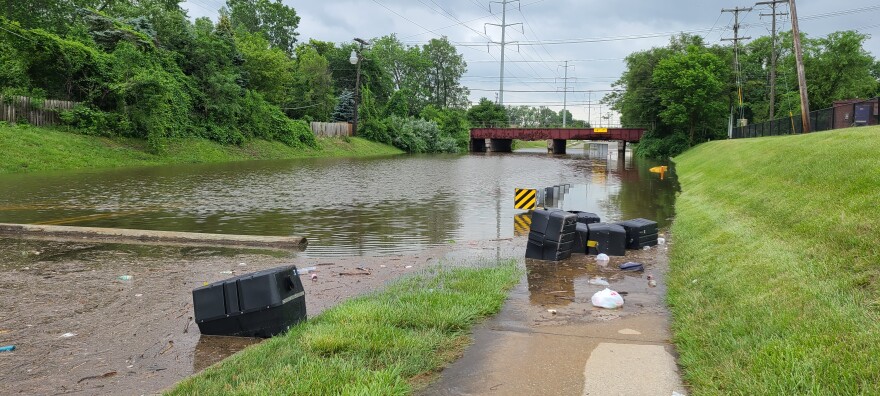While experts are confident that climate change will bring more rainfall and flooding to southeast Michigan in the coming years, that doesn’t mean every corner of the region will experience it equally. Some communities have already experienced repeated flooding over the past decade after historically intense and unprecedented rainstorms hit the area. And they stand to flood even more as the effects of climate change ramp up.
One of those places is Dearborn. That city sits just to the west of Detroit, specifically southwest Detroit, where the region’s major sewage treatment plant is located. That means it’s the end of the line for much of the area’s water and sewer infrastructure, with hundreds of millions of gallons of water flowing in from more northern and western communities every day.
The city experienced particularly massive flood events in 2014 and especially 2021, when about two-thirds of Dearborn homes got sewage water in their basements. Dearborn’s current mayor, Abdullah Hammoud, took the helm in 2022, making flood prevention and mitigation a top priority for his administration.
Basement flooding may seem like little more than a nuisance to some, but Hammoud said nothing could be further from the truth. “For many families in Dearborn, the basement is a living space,” he said. “And they had priceless things like their wedding pictures, wedding dresses, their furniture, their TV. And they had to take their livelihood, and put it at the curbside for a dumpster truck to come by and pick it up.”
The basic problem, as Hammoud sees it, is that the regional sewer system is designed to handle about three inches of rainfall per day. The 2021 storm dropped seven inches on some areas, all of it within an hour or two. And since all that water has to go somewhere, it ends up in people’s basements or on flooded streets.

Such storms used to be considered once-in-a-lifetime events, and many people assumed that would be the case after the 2014 storm. But climate change is making such storms both more frequent and more intense, and they seem to come roughly every 10 years now, instead of once in a generation.
Proposing solutions
To attack the problem, Hammoud directed the city to commission a two-year comprehensive assessment of its water infrastructure, “as well as the impact climate change will have, and how resilient our infrastructure is along that timetable,” he said. “We expect the results back in the spring of 2024.”
In the meantime, Dearborn is aggressively pursuing state and federal grants to finance infrastructure upgrades, as well as new infrastructure city officials hope will mitigate future flood events. The single biggest chunk of money the city has received so far comes from the U.S. Department of Housing and Urban Development’s (HUD) Community Development Block Grant-Disaster Recovery program. Dearborn is set to receive $27 million in those funds, and has a proposal for how it wants to use them.

The largest of those proposed projects is the Colson Palmer Stormwater Line, which funnels stormwater from northeast Dearborn to the Rouge River. Due to upstream development and more intense rainfall patterns, the line’s outfall is often underwater in the river. That means when the stormwater system is overwhelmed, it pushes that water out into other places, including nearby homes. The project would involve building some new infrastructure around the pipe, and clearing out sediment and debris that Hammoud said currently reduces its capacity by about 50%.
Other proposals include building more green infrastructure around the city, both on residential properties and those of major corporations, including Ford. Green infrastructure includes things like bioretention projects such as rain gardens, that can hold more rainfall and keep it out of the sewer system, or at least slow the flow until the system is ready to handle it.
Then there are additional federal grants that the city wants to use to put flap valves in Dearborn neighborhoods that have been hardest-hit by flooding. Hammoud explained flap valves this way: “It’s essentially like a backflow preventer, except on a main stormwater line. Now, not every residential home has to have it. We can stick it on one major sewer line and then we close it up. And that prevents the water from backing up into people's homes,” he said.
Bill Shuster, a professor of civil and environmental engineering at Wayne State University, said it appears that under the circumstances, Dearborn is “doing everything it can” to mitigate flooding.
“It sounds like they have a good start,” Shuster said. “They’re working at the municipal scale to dry out their system as best they can, through addressing the central issue of wastewater capacity on multiple fronts, which include residential, neighborhood, and sewershed scales.”
But Shuster added that it’s impossible for any municipality alone to really get a grip on the problem. He noted that like many communities, Dearborn sits in a “high-traffic area” for wastewater runoff. The city needs buy-in from its upstream neighbors to handle more of their own wastewater and storm flow, and remove it from the larger system so there’s more capacity once it reaches Dearborn.
“This becomes a societal issue very quickly, where all need to work together at the local and regional scales, and because the size of the issue is huge,” Shuster said.
Hammoud said the city hopes to have a “concrete pathway” to a comprehensive flood mitigation plan ready by 2024. But he said both the state and federal governments need to step up too, and make more money available for cities to do flood mitigation projects.
“Residents want immediate relief”

Sue Suchyta has lived in her Dearborn home for nearly 40 years. She and her husband raised their three children there, and Suchyta said she has no plans to leave, calling Dearborn “a wonderful place to live.”
Suchyta, who’s also covered local flooding issues extensively as a reporter for the Dearborn Times-Herald, said they never experienced any flooding until the 2014 storm. They got hit hard again in 2021, and now she said “it’s scary every time it rains.”
Suchyta thinks the city is “generally headed in the right direction” when it comes to flood mitigation, noting that the two-year engineering study still in progress should give city leaders “a lot of the answers.” But in the meantime, “residents want immediate relief,” she said.
Suchyta acknowledged that whatever measures the city eventually implements, it won’t be enough to completely resolve the problem. “We can't change the weather,” she said. “We have to find ways to get the water out of the system faster, so it doesn't back up in our basements. And I think that every Dearborn resident, that's their worry.”
That change, if it comes, could be too late for some residents. Linda Ratcliffe was born and raised in Dearborn, and still lives in the home her parents built in the 1950s. She loves that home too — or at least she did until it flooded the first time in 2014. Ratcliffe said she thought that was a “once-in-a-lifetime” nightmare experience.
But then came the 2021 storm. Ratcliffe said she woke up in the middle of the night and realized it was raining hard, but initially decided not to do anything about it until the morning. But then, “Before you know it, I could already smell something,” she recalled. “And I looked outside. Neighbors were crying and screaming, and there was water high up in the streets.”
Ratcliffe soon realized it had happened again, and this time it was even worse. The washer and dryer she had put on raised cement blocks after 2014 to protect them from future flooding were still destroyed, and Ratcliffe said the cost resulting from both storms has “ruined” her financially.

But things got worse. Ratcliffe, who had tried to clean up and sanitize the basement herself after the 2021 flood, realized she had mold growing. She said she doesn’t go down there anymore without a heavy-duty mask, but she can’t decide if she can afford the full cost of mold remediation, or whether it’s even worth it.
Ratcliffe thinks many people don’t understand the psychological toll that repeated flooding has on people who experience it. “I have no one come to my house because of this, because I can still smell the flood smell at times,” she said. “I don't know if it's all in my head or not, but it's not a smell that you can get rid of right away.”
Ratcliffe said between the financial and emotional toll of it all, she’s ready to move out of the house where she’s lived her whole life — if she can sell it.
“I understand they [the city] can't do anything overnight,” she said. “I understand there's talk about hope for people in the future. But I'm not going to be part of their future.”






